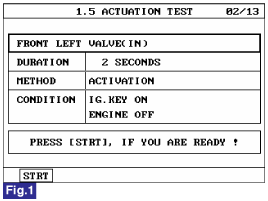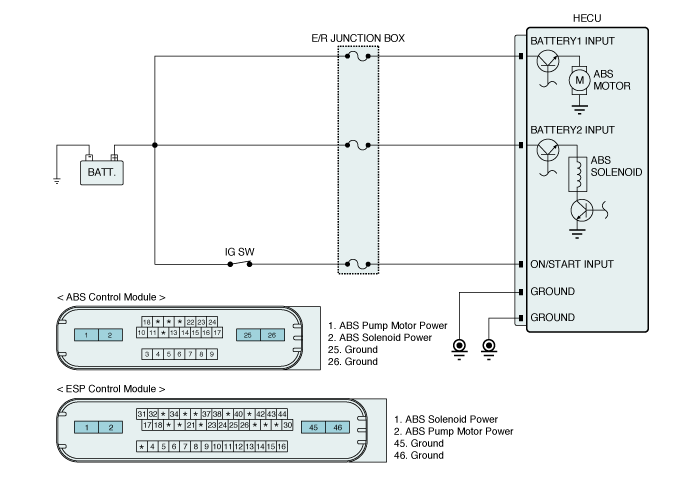Inspect operating status of all valves with Actuation Test.
Specification : It's normal if operating sound is heard.

Fig 1) Test Condition : Ignition "ON" & Engine "OFF".
Ex) Actuation Test on Front left valve(in)
The HECU supplies battery power to all soleonid valves with a valve relay which is controlled by the Electronic Control UNIT(ECU).
The valve relay and all solenoid valves are installed inside the HECU ( Hydraulic and Electronic Control Unit ).
ABS ECU monitors voltage of the valve relay to check if ABS ECU can perform ABS control normally.
When the valve relay is switched to ON, the HECU will set this code if the solenoid drive voltage is below permissible voltage ranges for a period of time.
When the valve relay is switched to OFF, the HECU sets this code if the solenoid drive voltage is over the permissible voltage range for a period of time.
Item | Detecting Condition | Possible cause | |
DTC Strategy | ● Voltage Monitoring | ● Open or short of power supply circuit (ABS2) ● Faulty HECU | |
Case1 (Open) | Enable Conditions | ● If the valve relay is switched on and the reference voltage of valve relay < 5±0.5V continuously for 56ms, the failure is detected. | |
Case2 (Short or leakage) | Enable Conditions | ● If the valve relay is switched off and voltage of valve relay > 6±0.5V or < 2.5±0.5V continuously for 56ms, the failure is detected. | |
Fail Safe | ● The ABS/EBD/ESP functions are inhibited. ● The ABS/EBD/ESP warning lamps are activated. | ||

Connect scantool to Data Link Connector(DLC)
Ignition "ON" & Engine "OFF".
Select the "Actuation Test" mode on the scantool.
Inspect operating status of all valves with Actuation Test.
Specification : It's normal if operating sound is heard.

Fig 1) Test Condition : Ignition "ON" & Engine "OFF".
Ex) Actuation Test on Front left valve(in)
Do all valves operate normally?
 | ▶ Fault is intermittent caused by poor connection in power harness (ABS2) and/or HECU's connector or was repaired and HECU memory was not cleared. Thoroughly check connectors for looseness, poor connection, bending, corrosion, contamination, deterioration, or damage. Repair or replace as necessary and then go to "Verification of Vehicle Repair" procedure. |
 | ▶ Go to "Terminal and Connector Inspection" procedure. |
Many malfunctions in the electrical system are caused by poor harness(es) and terminal condition. Faults can also be caused by interference from other electrical systems, and mechanical or chemical damage.
Thoroughly check connectors for looseness, poor connection, bending, corrosion, contamination, deterioration, or damage.
Has a problem been found?
 | ▶ Repair as necessary and then go to "Verification of Vehicle Repair" procedure. |
 | ▶ Go to "Power Circuit Inspection" procedure. |
Ignition "ON" & Engine "OFF".
Measure voltage between power(ABS2) terminal of the HECU harness connector and chassis ground.
Specification : B+
Is the measured value within specifications?
 | ▶ Go to "Ground Circuit Inspection" procedure. |
 | ▶ Check for open or blown 40A (ABS2) fuse referring to "Circuit Diagram". Repair open or short in power circuit between battery and HECU harness connector and then, go to "Verification of vehicle Repair" procedure. |
Ignition "OFF" & Engine "OFF".
Disconnect the HECU connector.
Measure resistance between ground terminal of the HECU harness connector and chassis ground.
Specification : Approx. below 1Ω
Is the measured value within specifications?
 | ▶ Substitute with a known-good HECU and check for proper operation. If problem is corrected, replace HECU and then go to "Verification of Vehicle Repair" procedure. |
 | ▶ Repair open or short in ground circuit between HECU harness connector and chassis ground, and then go to "Verification of vehicle Repair" procedure. |
After a repair, it is essential to verify that the fault has been corrected.
Connect scantool and select "Diagnostic Trouble Codes(DTCs)" mode
Using a scantool, Clear DTC.
Operate the vehicle within DTC Detecting Condition in General Information.
Using a scantool, Check DTC present.
Are any DTCs present ?
 | ▶ Go to the applicable troubleshooting procedure. |
 | ▶ System performing to specification at this time. |